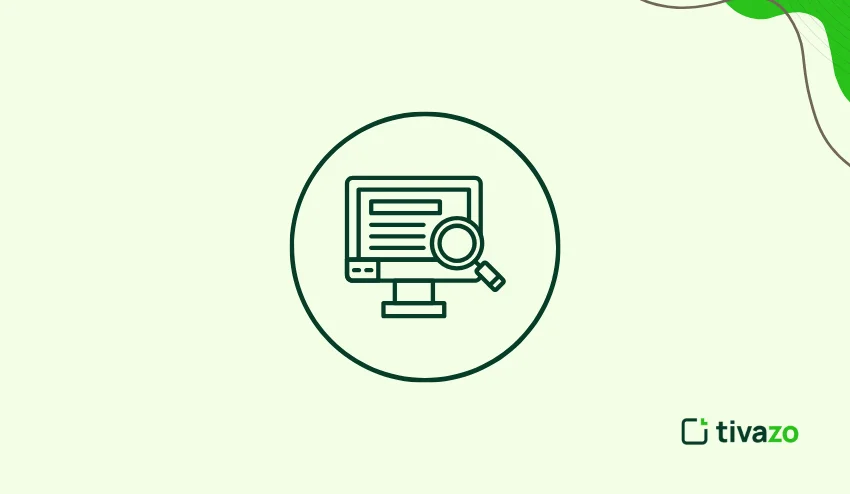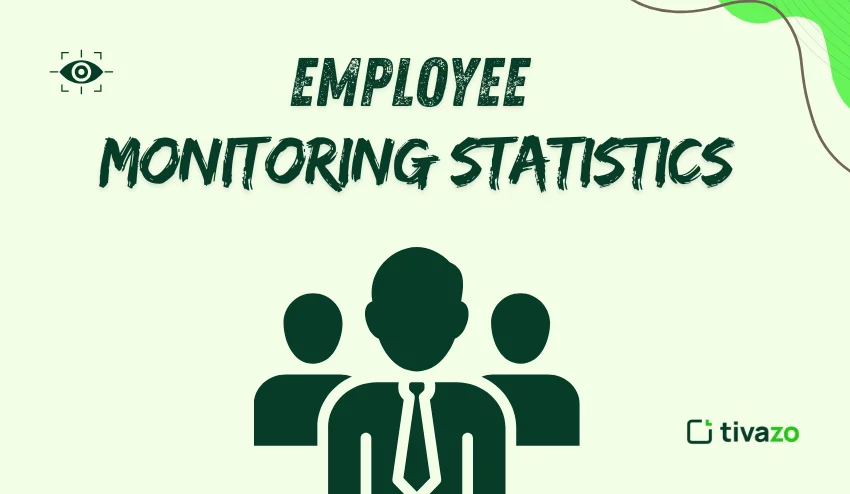In our hyperconnected world, even one social media post can determine how customers, investors, and even potential hires perceive your brand. Whether intentional or not, what employees post or share can play a role in an organization’s reputation, and it can have lasting implications.
As digital footprints increase and workplace cultures become online, employee social media monitoring has now become a staple of risk management. It supports your business in safeguarding image and compliance and protects your brand voice on the internet, especially in remote and hybrid work environments where the boundaries between personal brand and professional brand diminish.
This guide will help you decipher everything that hiring authorities and human resource leads need to know about social media monitoring of employees: What it is, why it matters, what can be legally monitored, how to implement transparent policies, what tools exist to assist in monitoring employees, and how to monitor employees without crossing the line and creating distrust. Let’s start with the most basic piece of information, employee social media monitoring, as it is defined.
What Is Employee Social Media Monitoring?
Social media monitoring refers to the monitoring and analysis of online activities, such as posts, mentions, comments, and shares, to gain insight into how audiences communicate about a brand. When utilized internally, employee social media monitoring refers to monitoring how employees represent or engage with the business on professional or personal profiles.
In simplest terms, it allows organizations to track how employee behavior online might impact the business’s reputation, confidentiality, and compliance. This does not equal spying on private and personal conversations. Instead, it allows organizations to track public post content, mentions of their brand, and complications related to their work, which could have real-world implications for the business.
Employers then usually employ monitoring software that will scan for keywords, hashtags, or mentions of the business name on social media, either public or private, related to the main platforms like LinkedIn, X (formerly Twitter), Facebook, and TikTok. Many monitoring tools can also identify potential policy violations and even potential data leaks in real time.
For the sake of example, if an employee were to post internal project details on LinkedIn by mistake, the monitoring software could alert the HR or PR team at the organization before it becomes a bigger issue.
When done ethically and transparently, employee social media monitoring protects both the business and its workforce, that is ensuring professionalism but still keeping sensitive information secure.
Reasons for Employers to Monitor Employee Social Media
Social media gives every employee a public voice and, in many cases, that voice represents the company, intentionally or not. Employers track employee social media not to control expression, but to defend their business from risks that they can from, liabilities that might be prevented, assets they might at risk, customers they protect, and team culture that matters to making their brand unique.
1. Protecting Brand Reputation
A company’s image comes from what its employees are willing to post online. A misplaced comment, thought, or controversial post can provoke backlash that often goes viral. Monitoring employees’ social media presence and employee posts gives employers awareness of problems, regardless of intention, before they become out of control.
Example: A customer service employee simply sharing screenshots of private conversations with clients could destroy trust in an instant.
2. To Prevent Data Leaks and Breaches
In heavily regulated industries like finance, healthcare, or Information Technology, an employee improperly sharing protected information online, even inadvertently, may be a quick cause not only injury where there may be legal penalties, but ultimately a systemic data breach. Monitoring their employee presence generally serves as an early warning only to unauthorized or inadvertent disclosures.
3. Upholding Appropriate Work Conduct and Values
Online conduct is frequently indicative of the in-person work conduct. Employers frequently use social media as a monitored, under-the-radar tool to ensure their employees do not participate in behavior like harassment, hate, mistrust, and other unethical and diversity conduct.
4. Monitoring for Insider Threats and Security Problems
Sometimes, malicious insiders use social sites to disclose information or talk badly about their organizations. Social media monitoring can help to see observable patterns to suggest that someone may be a risk of insider security, or someone may be a risk before someone is physically or emotionally compromised.
5. Determining Employee Sentiment
By monitoring overall employee tone or engagement in professional networks (ie. LinkedIn), HR teams can monitor employee morale, alignment with the organization culture, and communication barriers. It is important to note that social media monitoring is not about invading a person’s privacy. It is about offering information.
With transparency, monitoring an employee’s social media is a measure of accountability while enhancing the culture of professionalism and trust.
What Can Employers Legally Monitor on Social Media?
One of the largest concerns related to employee social media monitoring is legality, specifically, what employers have the ability to track, and what they do not track? The general overriding principle: companies cannot monitor any employee activity that is private or personal, but can track public, work-related, and policy-related activity.
1. Publicly Available Content
Employers are able to view and track any content that employees share publicly (e.g. tweets, public facebook posts, or LinkedIn updates when the company name, product, or customer name is mentioned). If the content is publicly available, it is reasonable to monitor.
2. Work-Related Accounts and Company Devices
Generally, there are many monitoring-related laws that might permit the monitoring of employee social media activity if that activity is taking place in a work-related account or on a company-owned device. This includes any posts, messages, or uploads made from employers’ devices or while using company wifi, assurance of compliance on the performance of employers’ issues, and the genuine interest in protecting employers’ business assets and compliance on company-related devices.
3. Brand Mentions and Hashtags
Monitoring tools frequently search for the company’s name, ancillary hashtags, or campaign hashtags. Monitoring brand mentions and hashtags is important to understand how employees are communicating about your organization online and whether the way they interact with the public is impacting how the public views the company.
4. On and Off the Clock Conduct
Employers should be careful when monitoring social media conduct while employees are off the clock. However, if the employee made a post that violated company policy in any manner (such as discrimination, leaking confidential information, or harassment), the company can take action, given it is public and the incident happened off the clock.
5. Regional Legal Variations
Privacy laws differ worldwide:
- United States: Protected by NLRA, employees discuss work conditions, but the employer can take action for public misconduct or leaks regardless (discriminatory comments).
- European Union: Under GDPR, monitoring must be proportionate, transparent, and in the interest of a legitimate business need.
- Canada & APAC: Consent and Purpose Limitation is key, and blanket monitoring is not acceptable.
Employers always have to communicate monitoring policies clearly, gain consent when required, and document reasons for any monitoring activity. Transparency protects both sides.
| Can Monitor | Cannot Monitor |
|---|---|
| Public posts and brand mentions | Private messages or locked accounts |
| Work accounts and company devices | Personal device activity outside work |
| Content that violates company policy | Political or personal opinions not tied to work |
| Data needed for compliance/security | Personal data unrelated to the job |
Is Employee Social Media Monitoring Legal and Ethical?
Legality answers “can we?” But ethics can ask ask the more important question “should we?” If your monitoring is legal, monitoring still needs to be done responsibly, transparently and with consideration of employee privacy.
1. Employer Rights Vs. Employee Privacy
Employers, over time, have a right to protect company assets, reputation, and information. Employees (especially in the workplace) have a right to privacy, just raises an ethical dilemma. Here is the good news: ethical monitoring is perfectly possible. It just requires ethical monitoring to focus on work-related content and not employee opinions, messages, or non-work conversations/texting.
Tip: Always get written consent from employees using an official employee monitoring policy.
2. Keeping It Transparent to Build Trust
Secret monitoring breaks down employee morale. Employees should be made aware on the front end what is being monitored, why it needs to be monitored, and how those results might be used. Transparency upfront turns inspection into a collaborative process.
3. The Principle of Proportionality
In privacy frameworks such as GDPR and EEOC guidelines, monitoring should be proportional (meaning the level of monitoring should equal the risk you are monitoring). For example, a financial institution may require a stricter level of monitoring than a creative agency, but in either case there should be a level of respect for privacy.
4. Ethics Beyond Compliance
Whether legal requirements are satisfied or not, employers should ask themselves:
- Is this level of monitoring necessary?
- Does this strategy correspond with the culture of the organization?
- Does this level of monitoring negatively impact trust and inclusion unintentionally?
Ethically conscious monitoring should be centered around prevention and education rather than punishment.
5. Document and Review Regularly
Policies should be updated at least once a year to keep up with changing laws and technology. Documents of employee consent and communication regarding policy will ensure that all parties are protected if necessary and shape compliance.
| Legal | Ethical | Practical |
|---|---|---|
| Public post monitoring | Transparent communication | Protecting brand reputation |
| Device usage policy | Proportionality | Minimizing HR conflict |
| Employee consent | Respect for privacy | Efficient crisis prevention |
How to Develop a Transparent Social Media Monitoring Policy
A transparent, well-communicated policy ensures employees have an understanding of the specifics about what is monitored, as well as why and how you respect privacy. It offers legal protection for the company and inspires trust and transparency in your relationships.
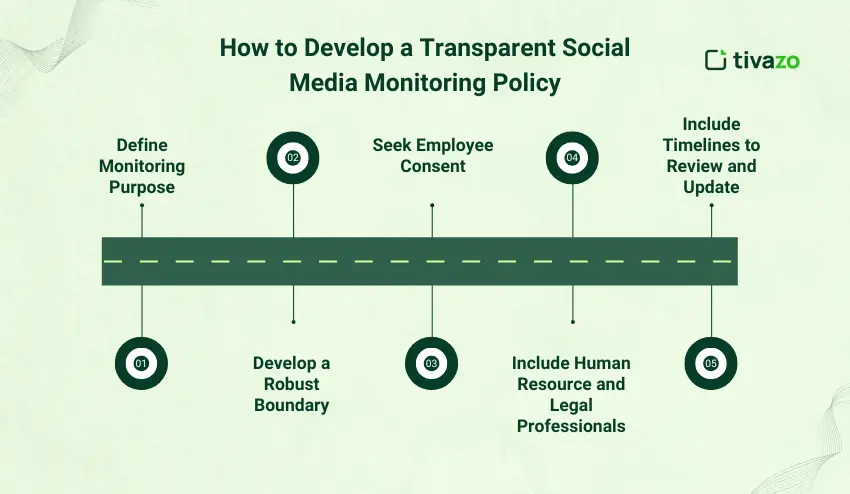
Step 1: Define Monitoring Purpose
Start by identifying the monitoring purpose. Is it for protecting your brand reputation, understanding and preventing data leaks, maintaining compliance, or ensuring that behavior is appropriate in the workplace? Having monitoring objectives defined will assist with the policies and reduce vagueness.
Step 2: Develop a Robust Boundary
- Identify what will be monitored. For example:
- Publicly available social media posts about the company or clients
- Non-personal activity on accounts the company manages
- Behavior that would determine compliance or security that the policy would address
- Identify items that won’t be monitored (for example, personal posts not pertaining to your work, private messages).
Step 3: Seek Employee Consent
- Set a precedent of transparency. Employees should:
- Be notified in writing and
- Know the scope of monitoring
- Sign off that they have been made aware of the policy.
Building this trust will create a positive relationship and reduce avenues for legal proceedings.
Step 4: Include Human Resource and Legal Professionals
Your HR department should be mindful of employee communication that relates to corporate policy and ensure that the employee social media monitoring policy mirrors other applicable internal policies. Legal representatives should be consulted to ensure compliance with applicable state privacy legislation and employment laws
Step 5: Include Timelines to Review and Update
Social media changes by the minute, laws change, and all companies change. Be sure to re-evaluate the policy at least once per year.
Best Strategies for Creating Your Employee Social Media Monitoring
Monitoring employees’ social media engagement is not just about the technology; it is about strategy, transparency, and employee trust. Following the best strategies will ensure that monitoring becomes beneficial, ethical, and legal.
- Explain to Employees the “Why”
Provide a straightforward explanation of every element being monitored. Be clear that the monitoring is meant to protect the company, support employees, and prevent risks, not to invade their privacy or get them in trouble. When employees know what you will be monitoring and why, they will be more receptive to learning about the monitoring. - Train and Prepare the Managers and HR Personnel
Train managers and those in HR on how to ethically and appropriately read employee social media accounts. Training should cover:- Legal limits and concepts
- What to look for and what will warrant action
- Maintain Confidentiality
- Create Limits Around Access and Avoid Over-Monitoring
Monitoring should involve only essential parties using the tools, which means only authorized personnel should access the monitoring tools. To further help maintain employee acceptance, only review the necessary data and avoid reviewing all posts. Incessant and unnecessary monitoring may create mistrust and damage performance and productivity. - Review Monitoring for Compliance
Conduct compliance reviews of how employee social media monitoring is utilized. Review use for the monitoring policy, compliance with all legal concepts, and for ethical considerations. If adjustments to monitoring, update the employee policy to reflect any. - Phased Roll Out for Companies with Remote Employees
If the company has employees working hybrid or remote work, consider a period of increasing levels:- Pilot a small group of employees in monitoring accounts
- Determine and analyze feedback for from employees in the pilot
- Amend policies, tools
Top Tools for Employee Social Media Monitoring in 2025
1. Tivazo
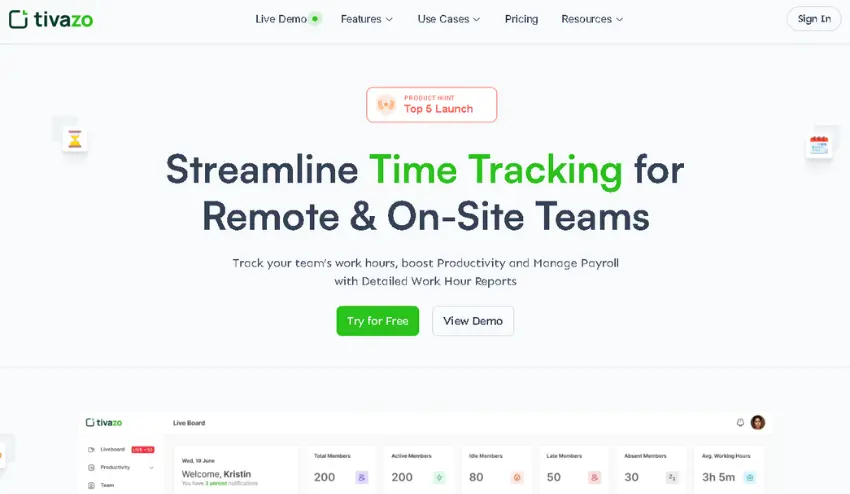
Overview: Tivazo is a platform for time tracking and employee monitoring that includes capturing screenshots, idle time detection, live monitoring, and team performance analytics. While Tivazo is presented largely as a time tracker, it contains a number of features that can be used for social media/online activity monitoring (e.g., live monitoring, analytics, reports).
Key Features:
- Time tracking (manual and automatic)
- Live screenshot capture with an optional masking for privacy
- Idle-time detection, activity tracking, and performance analysis
- Integrations with Slack, Google Calendar, Jira (coming soon)
- Privacy/respect- rights features: employees can see their own monitoring data, configurable privacy settings per role/department.
Price:
- Free/Freemium plan: an initial plan for up to 10 users, and limited features.
- Business plan: USD $3.00 per user/month (for teams beyond 10) based on one listing.
- Enterprise: Custom pricing for large teams, unlimited users, advanced reporting, and SLA.
- Why it’s different: It is a well-balanced tool that focuses on productivity and transparency, not so much as a tool for intensive monitoring; it is affordable for small teams, and it is a good option if you want to monitor employee online behavior beyond just use of social media as employee activity overall monitoring.
- Caveats: it may not have as many social-media-monitoring features, such as sentiment analysis of posts, brand mentions, etc., compared to tools built specifically for social media monitoring.
2. Hubstaff
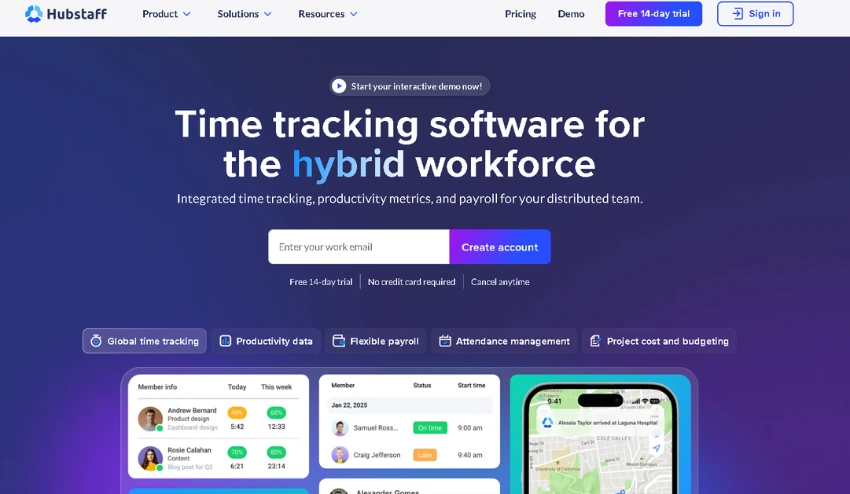
Overview: Hubstaff is an employee and workforce productivity and monitoring solution, offering a range of services including time tracking, app and URL tracking, screenshots, and analytics. Also of note, the solution clearly notes that it includes monitoring of social media/web use functionality in its offering.
Key Features:
- Web & App Usage tracking (includes social media/web usage)
- Screenshots, activity levels, productivity analytics
- Payroll, timesheets, and GPS time clock for field teams (even broader workforce management)
- Integrations: Lots of tools (like Jira, Trello, Slack, etc).
Pricing:
- Starter: ~ US $7 per user/month.
- Grow: ~ US $9 per user/month.
- Team: ~ US $12 per user/month.
- Enterprise: Custom pricing with advanced features.
Why it Stands Out: Strong as a workforce management platform for companies that want robust monitoring of time, desktop/web usage, and social media usage by employees; mature product with many integrations and features.
Considerations: Slightly high cost, especially if the customer is adding on tools or features from the enterprise pricing; very time and activity tracking focused, so implementation of policies or procedures should be communicated clearly to avoid privacy / ethical concerns.
3. Time Doctor
Overview: Time Doctor is a tool aimed at improving productivity and monitoring employee performance, with an emphasis on monitoring of web/app use, screenshots, tracking of time, and workflows. It’s also widely shared in the context of remote/hybrid teams and has some usable features for social media use as an effective business tool.
Key Features:
- Time tracking, web, and app usage monitoring
- Screenshots – unlimited
- Productivity analytics – in-depth
- Integrates with over 60 tools to track productivity and workflow
- Activity alerts with activity alerts
Pricing:
- Basic: ~ US$6.70 per user/month (yearly prepay) or ~ US$8 per user/month (monthly pay)
- Standard: ~ US$11.70 per user/month (yearly prepay)
- Premium: ~ US$16.70 per user/month (yearly prepay)
- Enterprise: Custom.
What sets it apart: Good for remote teams, strong clarity around social media/integration monitoring, and finds the balance between monitoring employees and trusting employees.
What to keep in mind: Similar to the other platforms, you will need to set and communicate the policies clearly, while also making sure that more of the features are focused on tracking time than they are on monitoring your brand on social media.
| Tool | Starting Price* | Strengths | Ideal For |
|---|---|---|---|
| Tivazo | Free up to 10 users / ~ US $3/user/month for Business plan SaaSworthy+1 | Transparent monitoring + productivity focus | Small to mid teams wanting balanced oversight |
| Hubstaff | ~ US $7/user/month and up Hubstaff+1 | Strong usage tracking + integrations | Companies needing detailed activity & social media tracking |
| Time Doctor | ~ US $6.70/user/month (annual) Capterra+1 | Remote/hybrid team focus + trust‐aware | Remote teams wanting productivity + social media awareness |
Conclusion
In today’s workplace, employee social media monitoring is no longer an option; monitoring employees’ social media accounts is an important component of workforce management. By analyzing employees’ public posts, association with work-related accounts, and behavior that could affect policy, organizations can defend their brand or services, prevent disclosure of proprietary information, and ensure that workplace behavior is aligned with organizational expectations.
Nonetheless, monitoring must always be a legally, ethically, and problematically balanced decision. Monitoring laws vary by jurisdiction, and an ethical strategy should consider employee consent. Organizations should implement monitoring that is proportionate, in case of future litigation, and allow employees an opportunity to establish trust. Monitoring devices, such as Tivazo, Hubstaff, and Time Doctor, have made social media monitoring easier to implement, but the real success will come down to how both technology implements a thoughtful policy and how policy is communicated.
At the end of the day, effective employee social media monitoring shouldn’t be about employee surveillance, but instead employee protection, professional business practices, and fostering a responsible online culture. Organizations can monitor successfully, with little chance of breaching employee trust, by implementing best practices, appropriate tools, and conducting legal monitoring.

